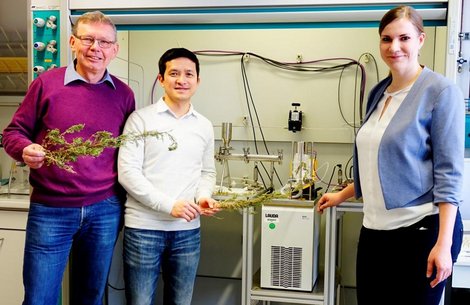Green chemistry in the fight against malaria

Researchers from Saxony-Anhalt discover the efficient production of medicine to fight the tropical disease
Thanks to the improvement of chemical processes, researchers have succeeded in obtaining bigger quantities of the anti-malaria active ingredient Artemisinin from an Asian plant. The production is now more rapid and more environmentally-friendly than before. Scientists at the Max Planck Institute for Dynamics of Complex Technical Systems in Magdeburg are playing a significant role in the research.
In many poorer countries, malaria is a widespread infectious disease. Some 650,000 people die of malaria every year, almost 90 percent of whom are children under the age of five. Although the disease can be treated, many people in developing countries are unable to afford the anti-malaria medicine. This situation could change in the future, however, thanks to research by scientists at the Max Planck Institute of Colloids and Interfaces near Potsdam and the Max Planck Institute for Dynamics of Complex Technical Systems in Magdeburg.
A plant from Asia produces an anti-malaria agent
In the 1970s, a scientist in China isolated the active agent Artemisinin in an Asian mugwort plant known as "Qinghao" (Artemisia Annua). The plant produces the protection against malaria over the course of a year to ward off its predators. It has a healing effect on people who are infected with malaria. Extracting a sufficient quantity of Artemisinin from the plant is not easy, however. The amount of Artemisinin in the leaves and stems varies according to the growth of the plants. Even at the optimum harvest time, the proportion is barely any more than one percent of the dry mass of the plant. Therefore, until now, a very considerable amount of the plant mass has been required to obtain the active ingredient. Malaria medicines are therefore relatively expensive.
Scientists have improved the extraction of the active agent
At the beginning of the 21st century, the research group under the aegis of the biochemist and professor Dr. Peter Seeberger, director at the Max Planck Institute of Colloids and Interfaces near Potsdam, discovered that a precursor substance for Artemisinin formed by plants before their harvesting could be converted into Artemisinin under laboratory conditions. This means it is possible to gain larger amounts of the anti-malaria agent from the plants.
Five years ago, Seeberger entered into contact with the process engineer prof. Dr. Andreas Seidel-Morgenstern from the Max Planck Institute for Dynamics of Complex Technical Systems in Magdeburg in the interests of further optimising the individual steps in the process and the complete material recovery process.
Environmentally-friendly and more cost-effective production of active agents
In the course of this collaboration, one of the significant steps forward was the finding that in order to obtain the Artemisinin precursor, the addition of a catalyst is not required. In her doctoral thesis, Susann Triemer, a doctoral student at the Max Planck Institute in Magdeburg, succeeded in demonstrating that the green dye of chlorophyll which is produced by the plant can be used as a light-sensitive photocatalyst for the synthesis of the Artemisinin. "That's green chemistry," says Susann Triemer: the environmentally-friendly production of active agents which also reduces costs.
Faster than nature
In the laboratory, the reactions take place in hoses that are the size of a drinking straw. At a temperature of minus 20 degrees Celsius and an overpressure of six bars, the liquid plant extract flows through the tube reactors on a continuous basis. Under artificial light, the researchers have already achieved an Artemisinin yield of 67 percent. "Under laboratory conditions, in the space of a few minutes, we can do what the plant would take several days to achieve," explains Triemer.
The researchers at the Max Planck Institute in Magdeburg are working on further improving the efficiency of the process chain so as to increase the yield of the anti-malaria active agents. In this respect, they are cooperating with Prof. Dr. Eng. Ulrike Krewer, Dr. René Schenkendorf and doctoral student Moritz Schulze from Braunschweig Technical University. They will be helping with the mathematical modelling of the processes. "We have to maintain an overview of the entire process chain, as it is only possible to produce Artemisinin without any hitches if there aren’t any bottlenecks," explains Professor Seidel-Morgenstern.
From the laboratory to the industrial scale
In principle, the technology is sturdy enough to be used in developing countries. In 2012, professor Seeberger launched the start-up company ArtemiFlow GmbH to test out the practical suitability on an industrial scale. With financial support from the Bill & Melinda Gates Foundation, it intends to create a test facility on an industrial scale. If the test runs are successful, production plants of various sizes are conceivable in many different parts of the world.
Author: Uwe Seidenfaden
